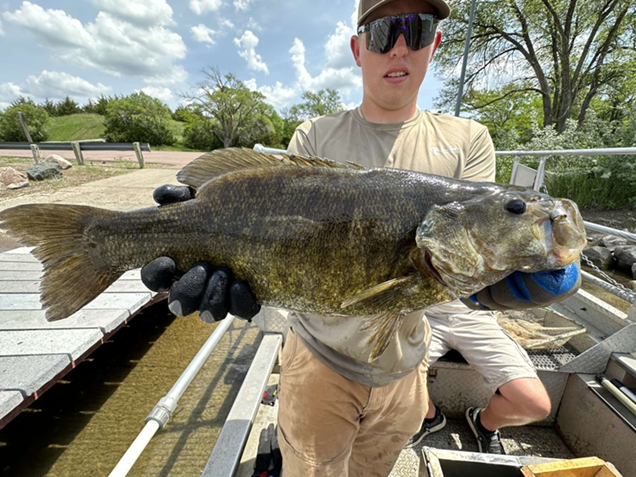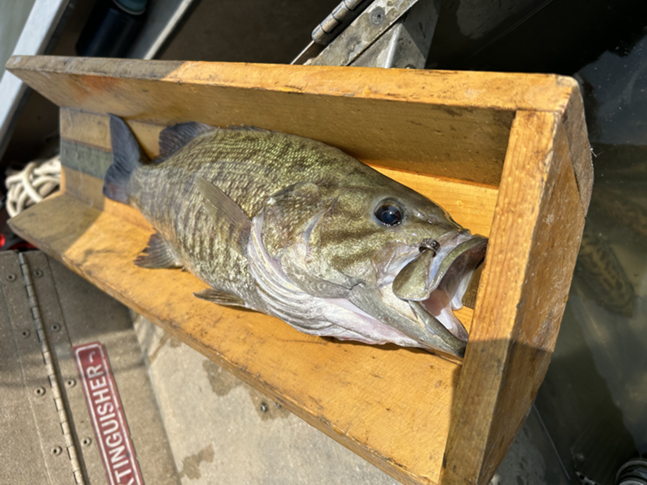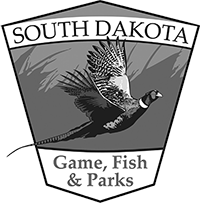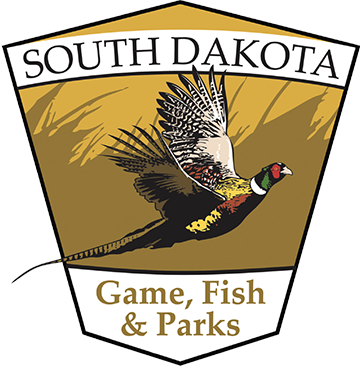Lake Sharpe Smallmouth Bass Tagging Project
Background for Research
Walleye has been and continues to be the most targeted species on the Missouri River and across South Dakota. While walleye is king, smallmouth bass are commonly the second-most sought-after species, particularly on the Missouri River. In recent years, the trophy-level smallmouth bass fisheries on the Missouri River have garnered much attention from national, regional, and local angling communities. As the interest on these bass fisheries have increased, concerns have been expressed from the angling public regarding the need for potential harvest regulations to protect and increase the abundance and size structure of smallmouth bass in the Missouri River. In response to such concerns, fisheries researchers with South Dakota Game, Fish, and Parks (SDGFP) formulated a study to better understand how anglers are utilizing these bass populations and estimate both natural and harvest mortality rates on an annual basis.
Study Components
Beginning in May 2023, SDGFP staff began collecting smallmouth bass via boat electrofishing on the lower end of Lake Sharpe (approx. Joe Creek down to Big Bend Dam). Biologists collected the length of each bass and then fitted them with a uniquely numbered stainless-steel band on their upper jaw (see pictures below). Between mid-May and mid-June 2023, SDGFP tagged and released 1,831 total smallmouth bass. Of those tagged, 114 of them were reward tags worth $100 to the angler that caught and reported them. Similarly in 2024, SDGFP tagged an additional 1,609 bass (1,496 standard tags; 113 $100 reward tags). Signage was posted at most access sites on Lake Sharpe encouraging anglers to report if they caught a tagged bass at TAGS.SD.GOV.
Preliminary Results
The results of this study are reliant on anglers going online and reporting their catches of tagged fish to SDGFP at TAGS.SD.GOV. When an angler reports a catch, they receive a certification via email with some information about where and when their fish was tagged and what size it was at tagging.
 SDGFP recorded angler reported catches on the bass tagged in 2023 for one year post-release. At the end of the year, SDGFP estimated non-reporting and tag loss rates to adjust overall catch and harvest rates. In 2023, the non-reporting rate was estimated at 51.5%, meaning that over half the anglers that caught a tagged bass chose not to report it. Tag loss in 2023 was estimated at 36.1%. While this tag loss rate appears high, most this tag loss occurred from anglers catching a tagged bass, removing the tag, and releasing the fish. With these reporting and tag loss rates in mind, SDGFP biologists estimated that 59% of the bass population in Lake Sharpe was caught in 2023, indicating a high susceptibility angling. Additionally, most of the caught bass are released back into Lake Sharpe (64.4% release rate). However, it was estimated that 21% of the total bass population was harvested in 2023.
SDGFP recorded angler reported catches on the bass tagged in 2023 for one year post-release. At the end of the year, SDGFP estimated non-reporting and tag loss rates to adjust overall catch and harvest rates. In 2023, the non-reporting rate was estimated at 51.5%, meaning that over half the anglers that caught a tagged bass chose not to report it. Tag loss in 2023 was estimated at 36.1%. While this tag loss rate appears high, most this tag loss occurred from anglers catching a tagged bass, removing the tag, and releasing the fish. With these reporting and tag loss rates in mind, SDGFP biologists estimated that 59% of the bass population in Lake Sharpe was caught in 2023, indicating a high susceptibility angling. Additionally, most of the caught bass are released back into Lake Sharpe (64.4% release rate). However, it was estimated that 21% of the total bass population was harvested in 2023.
As stated above, many more smallmouth bass were tagged in 2024 and SDGFP will continue to monitor those tag reports through 2025. Anglers are strongly encouraged to continue reporting their catches. At the completion of the project in 2025, all data collected will be summarized and shared with the public via public meetings and/or journal publications. At this time, SDGFP will also evaluate if there are any harvest regulations that may potentially be beneficial for the bass fishery. As always, any potential regulation changes will go through a rigorous public comment process through the SDGFP Commission, allowing anglers to voice their input.

